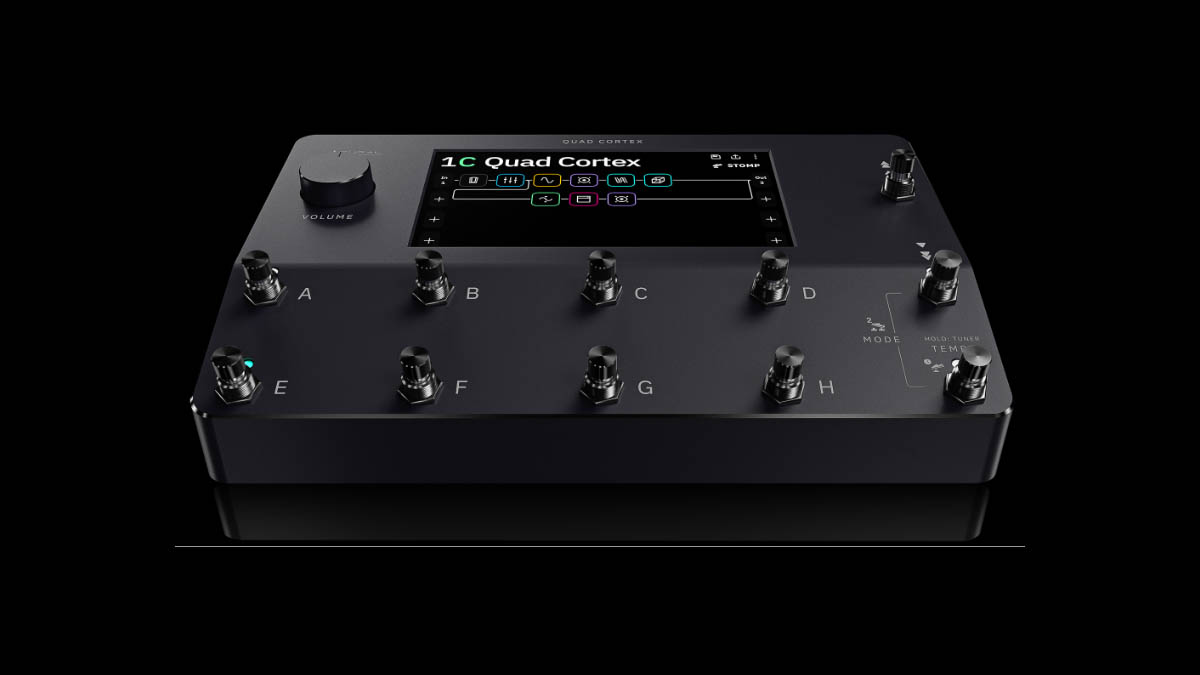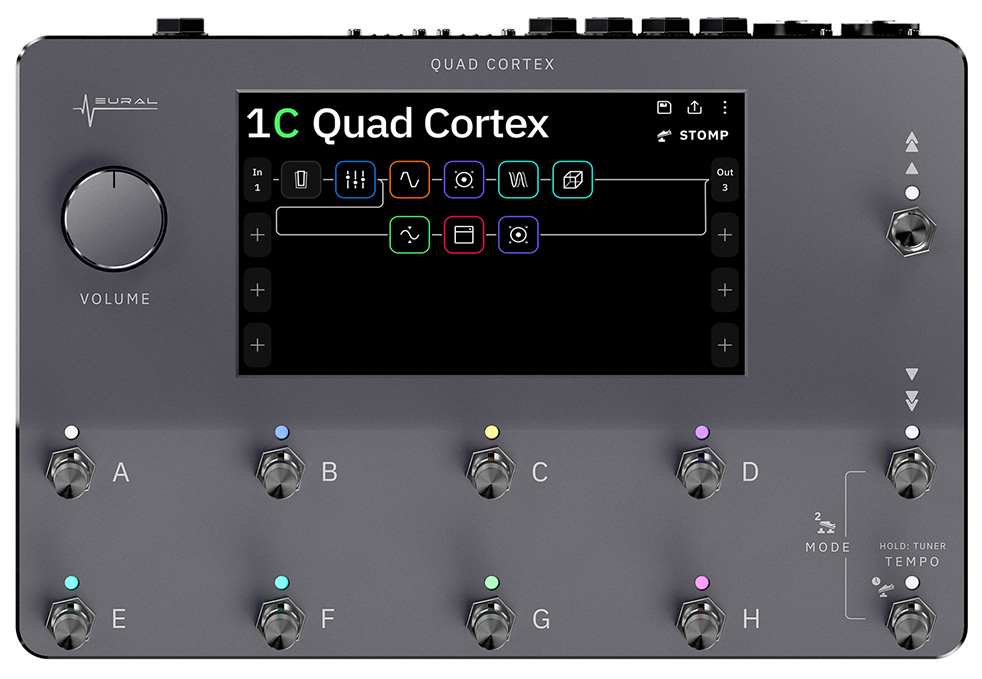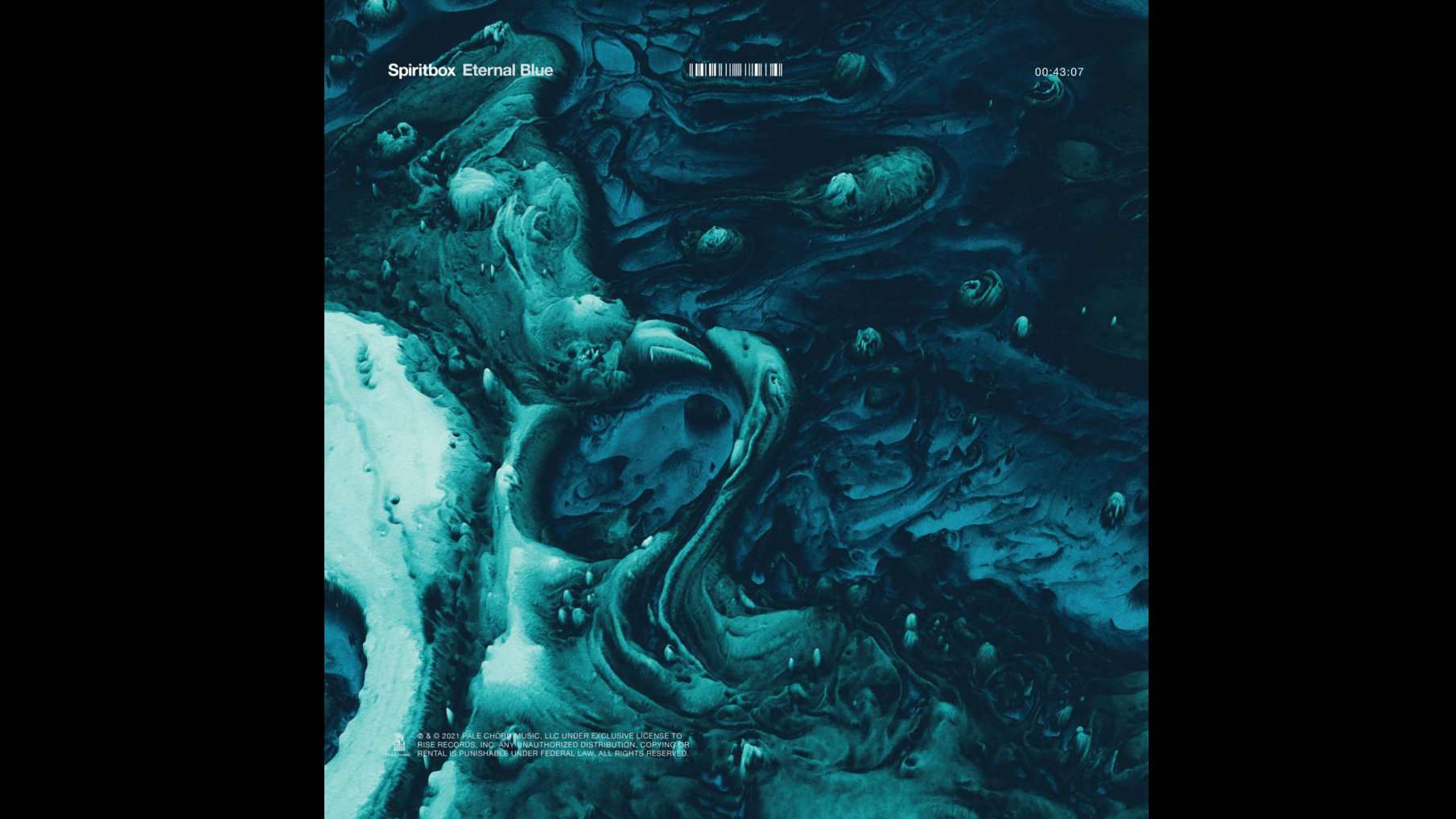Spiritbox: watch an exclusive guitar playthrough of Circle With Me and interview with Mike Stringer
The guitarist from THE heavy band to watch in 2021 demos the Neural DSP Quad Cortex
With their long-awaited debut album now confirmed for release in September, Canadian quartet Spiritbox are undoubtedly one of the most hotly tipped metal acts of 2021.
Formed in 2016 by husband and wife duo Courtney LaPlante and guitarist Mike Stringer – both previously having played in iwrestledabearonce – and later joined by bassist Bill Crook, the group have released a string of highly successful singles over the last few years, clocking millions of views and streams. This year’s debut, Eternal Blue, will include some of their biggest and best – including Holy Roller, Constance, Circle With Me and latest single Secret Garden – which, at times, fuse elements of nu-metal and tech death with industrial and electronica.
What we do is a little unconventional
“What we do is a little unconventional – using an eight-string tuning but on a seven-string,” explains guitarist Mike Stringer. “One of the key parts of keeping it all tight and in-check is having a multi-scale guitar and an EverTune guitar. I’ve seen so many comments where people are telling us we are tuned so low but it doesn’t sound muddy, and I attribute that to not only our multi-scale stuff but also our bass player, who plays a Dingwall bass. They are mandatory for those low-tunings, in terms of matching up to the guitars. Everything from the string gauges to the action has to be really well thought-out. That’s how we get away with it and found our sound. Without this gear, it would be flop city!”
As he explains in this MusicRadar interview, the new album was mainly recorded using his Aristides seven-string guitar fitted with Lundgren pickups, going into a Neural DSP Nolly plug-in. The connection to Neural DSP doesn’t end there, however. The Quad Cortex used in his latest playthrough for Circle With Me above, which he describes as “more simple and precise than anything else out there”, will also become a fundamental part of the guitarist’s live rig...
We noticed you were using an Abasi Concepts eight-string in the video for your latest single, Circle With Me…
“Yeah, that’s an Abasi Larada… it’s quite the guitar, to say the least. Funnily enough, the song itself was recorded on a seven. Most of the record was done with a seven, but I knew the Abasi guys and with the whole colour of the video being blue, I didn’t have a blue guitar! So, as a shot in the dark, I just asked if they had a Blue Larada I could use and Tosin said he had an eight-string.
“We tune pretty close to an eight-string tuning, so it kinda felt like the same thing. I said, ‘Sure, let’s do it!’ So that’s how it came about. I didn’t think anyone would really notice but some people were freaking out saying, ‘Hey, that’s an eight-string, you should be playing a seven!’ They were a bit taken aback by it, and it’s cool people care, I guess.”
Get the MusicRadar Newsletter
Want all the hottest music and gear news, reviews, deals, features and more, direct to your inbox? Sign up here.
A lot of players, even if accustomed to seven-strings, feel eights can be quite hard to get to grips with. What was the transition like for you?
“I generally dislike eight-strings too. It can feel like too much, if you know what I mean? But that Abasi guitar has something about the neck profile that makes it play like a seven, it’s way faster and skinnier. Usually when I pick up an eight, the neck is like a baseball bat and that’s why I haven’t found many I jive with that well.
“The Abasi is very special – it plays fast, it’s super lightweight and doesn’t feel bulky in shape. To me, it wasn’t that big of a stretch. It just made sense and only took a second to get reacquainted.”
I feel like we’re at the point – especially for live application – where these modellers can get really close
But you’re probably more known for playing Aristides and Balaguer guitars...
“Yeah, I still use the Aristides a lot. I made the record with that guitar, it’s an incredible multi-scale seven-string. I also have an Evertune Jazzmaster-shape seven-string called The Growler from Balaguer. That thing is classy as hell. I really like retro-looking instruments that have a modern take. I’ve got a few of these amazing guitars kicking around, it’s hard to decide which one I want to play a lot of the time (laughs)!”
And it seems that you’re a big fan of Lundgren pickups – made in Sweden and used by bands like Ghost and Meshuggah...
“The Lundgren pickups are insane. They have a very particular kind of sound. I’d never used them before and through them into my Aristides, and just fell in love. I feel like a huge part of our sound is that guitar with those pickups, because they handle extremely low tunings really well and also allow for clean tones to shine through… that kind of versatility is rare!"
As for the 'board, you seem like the kind of player who gets a lot out of your digital gear. Have you ever used much in terms of analogue effects?
“I haven’t had that much experience with pedals. The ones I’ve always taken to are the Strymon BigSky and the J Rockett Archer, which is a very unique boost. It’s funny, I feel like we’re at the point – especially for live application – where these modellers can get really close.
"Things like the Kemper, which I also have one of, and the Neural DSP, now they’ve come up with a hardware unit, are incredible. Even more so with the capturing that they do, the idea of taking a tone and just copying it. Live, if you can get it 95% there, it’s really not that different.”
Having that big screen there and everything saved makes the Quad Cortex feel like a practical option for touring musicians – it’s small, powerful and sounds amazing
What made you switch to Neural DSP?
“I ran an Axe-FX for eight years, it never failed me. Then I switched to Kemper, and I remember being very impressed with the feel of it. While that transition was happening, we were recording singles and starting to work on our record. It was our producer who showed me the Neural Nolly plugin… he’s a plugin dude and loves to record with DIs, and generally prefers the cleanest way of doing it.
“So we started recording with that Nolly plugin, I was blown away by it and it kinda became a part of our sound and how we record. It’s just so easy to do. You have a clean DI and throw it through that thing and it’s gonna sound pretty damn good. When they announced the Quad Cortex, I figured we were already using the Parallax plug-on bass, the Nolly for guitars and other ones for leads and cleans. If I could have that in a hardware unit, I knew it would be great…”
Well, it certainly looks and sounds like you were impressed…
“Sure enough, I got one and it was amazing. It’s so easy to use, the I/O options are incredible. It’s touchscreen so you can literally just scroll through. The Kemper sounds incredible but I’ve had entire performances completely wiped from it and I don’t know how or why. When that happens while you are on tour, it’s not ideal. I’m sure it hasn’t happened to everybody and doesn’t even happen to me all the time… but once, in my opinion, is too many. Having that big screen there and everything saved makes the Quad Cortex feel like a practical option for touring musicians – it’s small, powerful and sounds amazing.”

Listening back to the head getting A/B against the capture, there was absolutely no difference. It was one of the first times I’ve ever done a profile A/B and been seriously blown away
What advice can you offer in terms of getting the most out of one?
“What I find really helpful is the whole capture thing. Obviously Kemper could do the profiling too, but this makes that process much easier and I find it’s way more spot-on. We had an Omega Granophyre head, which is a crazy amp, in the studio while making the record and captured it. Listening back to the head getting A/B against the capture, there was absolutely no difference. It was one of the first times I’ve ever done a profile A/B and been seriously blown away.
“If you’re in a country with music stores that allow you to rent stuff – in Canada we have this big music chain that will let you rent pretty much anything. You take it home and bring it back a day or week or month later. If you wanted, you could rent every single amp and pedal you’ve wanted, put it through this thing and then take it anywhere with you. Neural have found a way to make that really simple and more precise than anything else out there.
“On top of that, sorry to rant, but they have this cloud system and an app for your phone. Typically, you need to plug modellers in and connect them to your editing software in order to download presets, but using Neural you can just scroll on your phone and when you find something you want, it’s as simple as pressing a button to wirelessly send it to your device. That’s crazy… that’s mental.”

What kind of built-in effects and presets do you tend to use?
“As far as effects go, we do a lot of detuning within songs. We might go from playing in F# and then go into this really heavy breakdown in E or D# or something. The pitchshifting on the Quad Cortex is really precise and there’s not much lag. A lot of them get close but this thing feels really good. You don’t have to compensate with more gain and the pick attack comes as the strings are hit. I love the delays and reverbs.
“As far as the amps, I’m pretty basic – if I’m not using that capture I have of the Omega, I’ll use a boosted 5150 blue channel or a really nice Friedman. There’s not a whole lot on there yet because it’s a brand-new thing, but with updates they are going to put so much more on it. With the cloud and all the presets, you can pretty much download anything anyone has captured. The possibilities are endless. It’s crazy we’re at this point, where that’s a thing!”
Given how many singles you released before announcing this year’s debut full-length, was it hard to decide what ended up on the album?
“Yeah, that was definitely a thing! It’s been a challenge, because we’re so used to the single game and that whole mind-set of putting out a song every few months. We’d see the feedback and what people say and build it from there. Making the record, we struggled a little bit because we had to think of it as a full body of work, not just one song here and one song there.
“The record being 12 songs long made me think about someone sitting there and if they could start at the beginning and end up at the end, and be cool with that. Because there’s a lot of records where people might want to skip tracks. We really went out of our way to make each song special with memorable parts that people won’t want to skip. That’s hard to do, and I hope we accomplished that… we put a lot of time and effort in, so let’s see what happens.”

You just have to look at it from serving the song and leave your ego aside. If there’s a song that requires less guitar and more production like synths and electronic stuff, you do it
Tracks like Holy Roller have a blend of metallic guitars alongside elements of electronica and industrial. What’s the secret to balancing your guitars against other instrumentation?
“That’s a great question. We’re at a really interesting point in music where a lot of styles are coming back in 10 or 20-year increments. I feel that nu-metal is very much coming back! But more importantly, it’s about finding a balance of all the things you enjoy. This new stuff definitely has a lot more of those elements – samples and loops and stuff. A lot of the time, they’re used as a writing tool. For example, Circle With Me probably wouldn’t have been made if it wasn’t for that 15 second loop you hear in the intro and which plays throughout the entire song.
“You just have to look at it from serving the song and leave your ego aside. If there’s a song that requires less guitar and more production like synths and electronic stuff, you do it. And you can have other tracks where you go heavier on the guitar, like Holy Roller, and be really over the top about it. It’s a balance. Ultimately, you have to recognise what’s best for the song.”
One of my favourite artists is John Mayer
As for your non-guitar influences, what other artists have inspired the Spiritbox sound?
“Courtney has such an eclectic taste. We’ll listen to anything from Rihanna’s last record to that new Lady Gaga album that came out last year… Chromatica is an amazing album. One of my favourite artists is John Mayer, though admittedly he’s kinda guitar-heavy but in a blues way. That’s the whole key of it. Don’t just sit there and only listen to one genre. There’s so much great music. Even if it’s top 40 or a Katy Perry song…
“Actually, funnily enough, there was a Katy Perry collab that ended up being one of my favourite tracks from last year. You can find inspiration in non-guitar music. In metal, that’s how you can get more creative with it too, by opening yourself up to all those new influences. A lot of bands end up sounding like one another… there’s only so much you can do with a breakdown!”
Spiritbox's new single Secret Garden is out now. The album Eternal Blue is released on 17 September 2021 via Rise Records. For preorders, merch and tour dates visit Spiritbox.
Amit has been writing for titles like Total Guitar, MusicRadar and Guitar World for over a decade and counts Richie Kotzen, Guthrie Govan and Jeff Beck among his primary influences. He's interviewed everyone from Ozzy Osbourne and Lemmy to Slash and Jimmy Page, and once even traded solos with a member of Slayer on a track released internationally. As a session guitarist, he's played alongside members of Judas Priest and Uriah Heep in London ensemble Metalworks, as well as handling lead guitars for legends like Glen Matlock (Sex Pistols, The Faces) and Stu Hamm (Steve Vai, Joe Satriani, G3).
“Every note counts and fits perfectly”: Kirk Hammett names his best Metallica solo – and no, it’s not One or Master Of Puppets
“I can write anything... Just tell me what you want. You want death metal in C? Okay, here it is. A little country and western? Reggae, blues, whatever”: Yngwie Malmsteen on classical epiphanies, modern art and why he embraces the cliff edge










